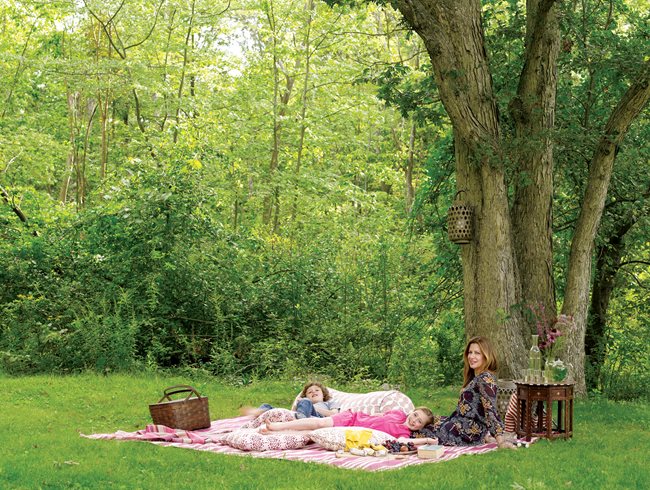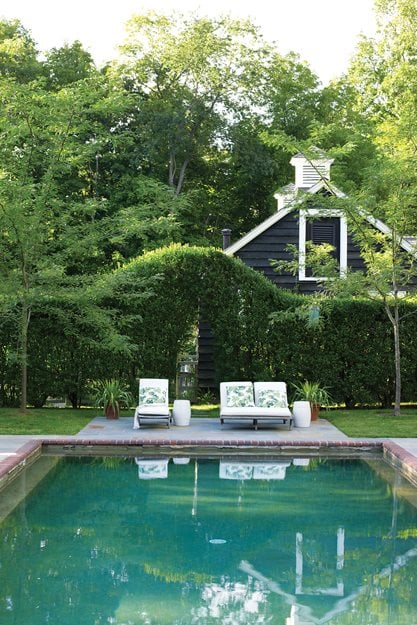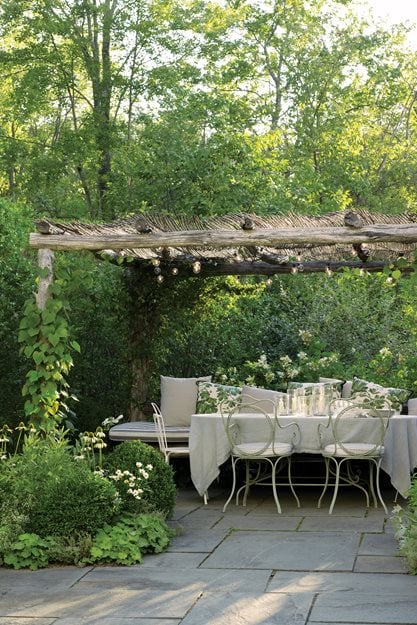Q&A: Deborah Needleman
Design guru Deborah Needleman, author of the new book The Perfectly Imperfect Home (and founding editor of Domino and current editor of WSJ.), describes her strategy for breaking the rules to create magical spaces and shows us her garden and home in New York's Hudson Valley.Deborah Needleman has been shaping the way people decorate their homes ever since she launched Domino, an influential (though short-lived) interior design magazine, in 2004. Blending a sophisticated understanding of decorating with a pragmatist’s love of simple, unpretentious style, Needleman assigned and edited stories that demystified the art of transforming interior spaces.

Needleman and her children, Lily, 12, and Nathaniel, 10, enjoy an instant Moroccan-style picnic on a shady spot of grass. Photo by: Ngoc Minh Ngo.
SEE MORE PHOTOS OF THIS GARDEN
Domino closed in 2009 (Needleman has since become editor of The Wall Street Journal’s monthly magazine, WSJ.), but this fall Clarkson Potter will release her new book, The Perfectly Imperfect Home. It’s full of tips and practical advice and, just like Domino, promotes a kind of informed rule breaking that is at the center of so much smart design.
While best known for her expertise on interiors, Needleman is also an extremely capable gardener. At a country house she owns with her husband, Jacob Weisberg, in Garrison, New York, she transformed what had been three sloping, weed-covered acres into a series of beds in a style that might best be described as Country Italian. It is organized brilliantly in the same friendly way Needleman does her indoor spaces. GARDEN DESIGN asked her to describe the philosophy behind her backyard, with its delightful play of simplicity and surprise.
What is your idea of the “perfectly imperfect” garden?
DN: It’s a garden that puts you at ease. The principles are the same whether you’re outdoors or indoors—you want spaces that are inspiring, calming, and comfortable—nice places to hang out, eat, rest, and chat. When I hear people referring to “plant material” and “hardscaping,” two words I hate, I know they won’t make gardens I love because they’re talking about materials rather than the point of it all.
How did your garden come together?
DN: I got a lot of advice from friends and was inspired by traveling and reading. I wanted to create a sense of magic. I love formal French and Italian gardens, places like Villa Gamberaia [overlooking Florence] that are almost entirely green and full of strict geometry. But that would look pretentious and uptight in my small garden, so I’ve gone about blurring the straight edges, messing things up.

Needleman extended pavers around the pool to create a lounge area. Photo by: Ngoc Minh Ngo.
SEE MORE PHOTOS OF THIS GARDEN
Where did you start?
DN: I was in my Italianophile stage, and so I terraced everything with dry-laid stone walls, separating the front walk, the pool, and the eating area into different areas. Then I added hedges and a box parterre on either side of the front door. It was overly formal until it got planted and decorated up. The vegetable garden came after my kids were born because I thought it would be fun for them. It requires a ridiculous amount of time and labor and money considering how easy it is to shop at the farmer’s market. And yet, I’d never give it up. I’m addicted.
How does the interior decorating spill into the garden?
DN: Everyone gets it about the need to create “rooms” or structure in the garden. But we also need to decorate those rooms! If you stop at flowers and a garden bench that no one ever sits on, it might look pretty, but it won’t be a place where any life happens. A lot of what makes you comfortable inside is worth exporting into the garden: soft seat cushions, pillows on the backs of chairs, low tables where you can set a drink or book. There is nothing better than throwing a big white linen cloth over a table under a tree, bringing out your good silver and glass, and having a long lunch. Using your indoor finery outdoors, from time to time, makes the experience more memorable and magical, probably because it is so impractical.
Are you against outdoor furniture?
DN: No, of course not, but a lot of outdoor fabric feels so stiff, and the pillows are stuffed so full they’re hard as bullets. Hollywood at Home has a line of beautiful all-weather fabric that looks and feels like linen.
How do you bring nature into the house?
DN: I love reminders of the garden inside—a big potted oleander says summer in Italy; a winter-flowering jasmine reminds me that spring will come. What delight does a spider plant, that lasts 20 years, offer? Garden plants indoors are precious because they don’t last long—like the pleasures of the garden, they are fleeting.
You’ve worked with some very famous decorators. What tricks have you learned?
DN: That soft light is more flattering than direct overhead light, and so the more you can soften and dapple sunlight, the better for everyone. It is true at night too—candlelight makes people feel sparkly and glamorous. Votives and hurricane lanterns are essential inside and out.
Also, when mixing a bunch of prints, contrast their scale and connect them with color. For example, on the pergola, I have a big flower print, a tiny stripe, and a bold stripe. You see stripes and florals together in a lot of great English rooms; why not use that combination outdoors? These fabrics look right together because they all have some brownish blue on them.

The outdoor dining area, just outside the kitchen, was inspired by trips to Greece. White linens from Society Limonata and hurricane lanterns from Henry Dean dress the table. Photo by: Ngoc Minh Ngo.
SEE MORE PHOTOS OF THIS GARDEN
What’s your favorite quick fix in the garden?
DN: The same way that compost fixes every soil ill, I think boxwood fixes every garden ill! If your garden is messy or has holes or the flowers look all jumbled and confused, throw some boxwood balls in and it will look great and purposeful.
What is the garden equivalent of good old silver?
DN: It depends on where you live, but for me it’s gravel. I guess it is about my love of grand Italian and French gardens, but when there is stone underfoot, it sounds so great and looks so elegant.
How often do you entertain in the garden?
DN: In summer, we eat outside as much as possible. If you set everything up, it’s not even like entertaining; you are just making big pots of food for everyone who is around.
I like to be in a garden—not just to look at it. I find that the more kinds of things you can do in a place, the more alive it seems. I stick chairs anywhere that seems hospitable to them. I even have them in the vegetable garden so that someone can stop by for a visit or you can have drinks there before dinner.
Do you need a bit of frippery outside as well?
DN: A bit of surprise is so fantastic. That’s why chandeliers are so delightful outside, because they don’t belong there. It is ompletely ridiculous but sometimes we drag the rug and all of the pillows from the sitting room onto the lawn and have a picnic under a tree. It’s as if we were Yves St. Laurent in Marrakech in the ’60s or something.
What’s the “perfectly imperfect” plant?
DN: I like plants that look a little wild growing together. I’m crazy for how Piet Oudolf combines plants. I do a recipe to get his look—blossom flowers (like echinacea) mixed with spires (like foxgloves or veronicastrum) mixed with umbellifers (like phlox or Joe Pye Weed). Weedy plants like grasses or gaura finish the secret garden look. Then if you add a little structure, like a hedge, it lets you cheat the wildness because it looks like you have it all pulled together.
Any thoughts on tools?
DN: Everything that is functional should also be pretty! If you bother to make a nice garden, you might as well care about the look of the things that lay around in it. I buy nice woven baskets for weeding and storing stakes whenever I see them, simple Dutch wood tools from Sneeboer, and plant labels from Le Prince Jardinier. If you’re in Paris, Deyrolle, the famous taxidermy shop, carries Le Prince Jardiner and is definitely worth a visit.
What do you wear to garden?
DN: In my head, I am wearing a pretty floral dress and belted cardigan and wellies. In truth, I work barefoot, no gloves, and usually in my bathing suit. I definitely have nothing to offer the style world here.
Cynthia Kling writes about gardening and design for numerous publications.
See more New York gardens
